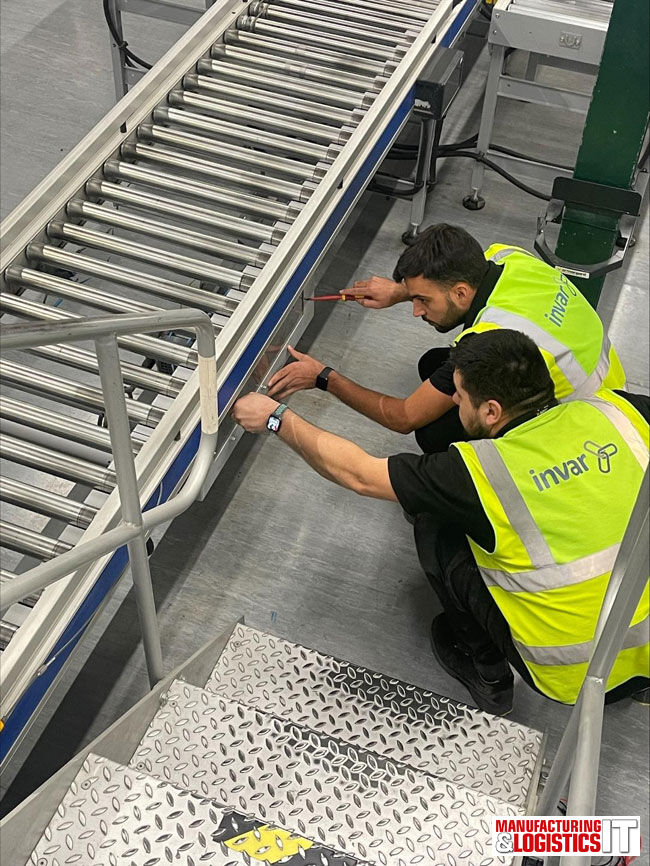|
Getting your Trinity Audio player ready...
|
Automation in its varied forms is increasingly ‘mission critical’ to warehouse operations. But with such high reliance on sophisticated systems, how do you ensure reliable performance and a risk-free peak? Dan Migliozzi, Head of Sales at independent systems integrator, Invar Group, looks at the options available for maintenance and support.
Advanced automation is transforming the efficiency, accuracy, and throughput of warehouses and distribution centres. But increasing dependency on technology brings risks. Unplanned downtime can no longer be covered by taking on more casual labour, even if this is available, or physically possible in a warehouse laid out for automated systems.
The cost of downtime, in a high-volume 24/7 operation or at the top of a vital seasonal peak, may be existential. Sadly, too many businesses only realise this when the worst has already happened.
So, for any warehouse operation with significant levels of automation, a robust strategy for maintenance, repair and support to minimise downtime is essential. But how can this be achieved? Here are five key points to consider:
1. Vendors and OEMs
For those with the luxury of a new build facility, it may seem that the original equipment manufacturers (OEMs) or vendors can be relied upon, there will be warranties and guarantees and some sort of service contract. But it is rare for all the automation to derive from a single OEM or vendor, there is much scope for dispute as to who is responsible. And if individual items of kit have had to be modified to integrate with other machines, the OEM may reject all responsibility.
As equipment ages, OEMs or their vendors may cease to offer support, or recommend that you update to the latest model. They may even leave the geographic or technical market entirely.
Further considerations, especially with overseas suppliers, are that support may already be outsourced, and of course that support in terms of both response times and pricing, are aligned with the vendor’s business model, not yours. A service contract with an OEM or vendor does not necessarily represent value for money.
2. The in-house option
Not so long ago it was commonplace to have an in-house maintenance team. That was fine when systems were less sophisticated and most problems could be sorted out by a dual trained mechanical/electrical fitter and a store of spare parts. However today, the required skill base is much richer, above and beyond the traditional mechanical and electrical skills that have always been essential. There are now further, elevated levels of expertise required, with deep knowledge on pneumatics, hydraulics and the many generations of electronics/control systems ranging from ‘simple’ PLCs to the software that informs autonomous vehicles and the like. Finding or training such individuals is not easy.
Even if you can staff that maintenance function, you then have the task of determining an appropriate monitoring and maintenance regime that keeps equipment operating at capacity while meeting manufacturing or other operational requirements. And, of course, there will be staffing issues around holidays or absence to contend with; not many in house teams have sufficient contingency to cover such eventualities.
In addition, it will be necessary to acquire and maintain an appropriate stock of spares, duly prioritised, knowing exactly where to source the less commonly required parts at short notice. Interestingly, maintenance, repair and operations (MRO) sourcing and inventory control can often be more complex, and administratively more costly, than the procurement of production parts. No surprise, then, that many businesses tend to downplay the risks they are running through inadequate support for warehouse automation.
3. Third parties and service strategies
A third-party maintenance and support specialist may be a favourable alternative to managing the whole process yourself, but this does require some serious thought. So, what should a warehouse operator be looking for?
Firstly, what level of service, in the broadest sense, is actually needed? This is a question that is inevitably coupled with risk. Ideally, this should be considered when the automation is acquired, but often that boat has sailed. Would a packing line breakdown, for example, stop the entire operation? Or are there workarounds that will keep things going, albeit less efficiently, for a few days? It’s a question of redundancy – and the answer may be far from uniform across the warehouse.
As an independent systems integrator, our approach with a potential client is to analyse every aspect of warehouse automation: possible failure modes, their frequencies, their criticality. What skills, and parts, do we need ever-present on site; what can we risk needing to bring in, and how confident are we of the sourcing? What are the appropriate levels and techniques for machine and condition monitoring, and what are the red lines for intervention? How does downtime for repair or maintenance fit with production or distribution targets?
Broadly, this analysis prescribes one of three approaches. There is a model where the maintenance contractor’s staff are fully embedded in the warehouse. And let us be honest. We are big advocates of planned and predictive maintenance, of serious condition and performance monitoring and so on, but we can’t always predict one-time failures. If such a failure would pose an existential threat, an embedded maintenance and support operation becomes a compelling option.
This approach offers a comprehensive, high-service level solution, and therefore is a premium service.
Similar analysis may suggest that, if risk is lower and unplanned downtime won’t, if swiftly addressed, impact the business, a ‘scheduled’ solution may be preferred. Here, the maintenance team turns up to a schedule, which may differ according to the nature of the equipment and agreed maintenance schedules – some might need weekly inspection or even complete strip-down and rebuild, other elements may be on much longer timelines. And, of course, the team is on call for unplanned emergencies.
Or for lower risk and relatively uncomplicated automation, a remote service may suffice for advice, instruction, sourcing parts and so on. That is also the approach advocated for control/software issues – you can’t feasibly trial patches when the system is up and running.
It is also important that there should be a well-established escalation system, so that a problem which cannot easily be resolved by the person in direct contact can be raised to someone who can fix it.
Whichever approach is chosen, it is important that it arises from a comprehensive assessment of risk, which can vary, especially across multiple facilities.
4. Technical capabilities
Few maintenance and support service suppliers can guarantee to have all the technical capabilities on tap – especially when it comes to software and the rapidly-developing field of robotics. However, an independent integrator with a team of in-house software developers, such as Invar Group, offers significant capabilities. In particular, we have over 100 staff worldwide working on the development, implementation and support of industry leading technology and we can offer a range of support services from a complete residential service, through to comprehensive remote helpdesk services, available 24/7.
Other factors to look out for when considering a service supplier are staff qualifications / certification, understanding of and adherence to Health & Safety and other principles, along with proof of experience with similar businesses. However, some third parties rely very largely on hiring skills as needed, which isn’t a responsible approach – indeed we reckon to serve around 85% of customer needs from our own resources. It’s worth noting that sourcing and procurement capabilities will be necessary too.
5. Continuous improvement and partnership
An important point to consider is that many third parties can, to a greater or lesser extent, be ‘tied’ to particular OEMs, vendors, or in some cases parts suppliers. This could lead to conflicts of interest or ‘unconscious bias’. Therefore, a level of independence allows for a ‘best practice’ solution to solving problems and sourcing the most appropriate / best value components.
It really isn’t enough just to address failures, and potential failure, as they arise. A competent third party will be continuously gathering and analysing data on failures, failure modes, and performance. And this shouldn’t be passive: it should be firmly linked to job tickets, costs of spare parts, downtime, whether there are repeating issues, and other KPIs, so that informed decisions can be made to enhance performance and improve up-time.
Warehouse automation is a significant, often critical investment in the future of the business, and therefore must function reliably day-in, day-out – particularly at peak. Your maintenance and support supplier needs to recognise and respect your business commitments, and work with you to ensure that up-time is maximised and the best possible performance of the system is maintained throughout. They also need to be prepared to do this across all your technologies and legacy systems, suggesting enhancements that deliver value.
As an independent, full-spectrum automated warehouse solutions provider, Invar Group is cognisant of the broad array of technologies used to support warehouse operations, and being a multifaceted organisation that brings together skilled individuals with competencies across warehouse management software, systems integration and controls, we have all that’s needed to de-risk warehouse performance.



